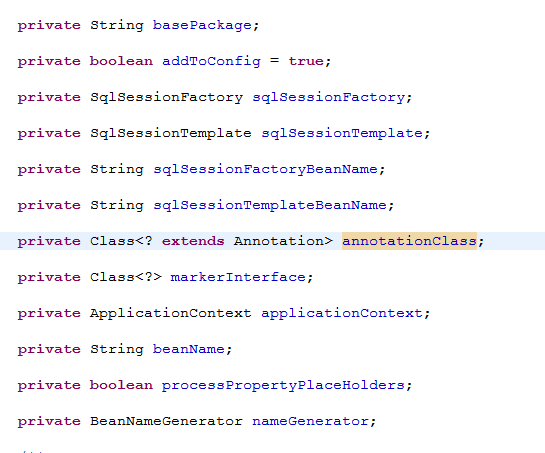MyBatis使用中有两种方式,一种是与其他框架集成,如与Spring集成(项目中大多采用这种方式)。另外一种则是手动获取sqlsession去进行数据操作(测试时会用)。
【1】不与spring集成
即,使用sqlSessionFactory获取sqlSession进行操作。点击查看:xml形式的增删改查
【2】与spring集成不使用MapperScannerConfigurer
不使用MapperScannerConfigurer,说明需要手动注册dao-Bean或者mapperBean于容器中。Controller或者Service使用方法仍然为调用该bean对应的dao接口方法去进行数据的一系列操作。
集成步骤
-
① 配置userMapper.xml (普通的增删改查等具体SQL);
-
② 配置spring.xml(核心配置文件);
-
③ 配置spring-userMapper.xml(将dao注册到容器中)。
spring.xml如下:
<beans xmlns="http://www.springframework.org/schema/beans"
xmlns:xsi="http://www.w3.org/2001/XMLSchema-instance" xmlns:context="http://www.springframework.org/schema/context"
xmlns:tx="http://www.springframework.org/schema/tx" xmlns:jee="http://www.springframework.org/schema/jee"
xsi:schemaLocation="http://www.springframework.org/schema/beans http://www.springframework.org/schema/beans/spring-beans-3.1.xsd
http://www.springframework.org/schema/context http://www.springframework.org/schema/context/spring-context-3.1.xsd
http://www.springframework.org/schema/tx http://www.springframework.org/schema/tx/spring-tx-3.1.xsd
http://www.springframework.org/schema/jee http://www.springframework.org/schema/jee/spring-jee-3.1.xsd">
<bean id="propertyConfigurer"
class="org.springframework.beans.factory.config.PropertyPlaceholderConfigurer">
<property name="locations">
<list>
<value>classpath:jdbc.properties</value>
</list>
</property>
</bean>
<!-- 数据源配置, 使用 DriverManagerDataSource -->
<bean id="dataSource" class="org.springframework.jdbc.datasource.DriverManagerDataSource" >
<property name="driverClassName" value="${driver}" />
<property name="url" value="${url}" />
<property name="username" value="${username}" />
<property name="password" value="${password}" />
</bean>
<!-- mybatis的SQLSession的工厂 :SqlSessionFactoryBean-->
<bean id="sqlSessionFactory" class="org.mybatis.spring.SqlSessionFactoryBean">
<property name="dataSource" ref="dataSource" />
<!-- 非注解dao,配置如下属性可以使用简单类名 !-->
<property name="typeAliasesPackage" value="com.web.model">
</property>
</bean>
<!-- 手动导入dao-bean配置文件 -->
<import resource="config/web/spring/spring-userMapper.xml"/>
<!-- *************事务管理******************* -->
<bean id="transactionManager"
class="org.springframework.jdbc.datasource.DataSourceTransactionManager">
<property name="dataSource" ref="dataSource" />
</bean>
<!-- 使用声明式事务 -->
<tx:annotation-driven transaction-manager="transactionManager" />
</beans>
配置spring-userMapper.xml (需手动导入到spring.xml)
该文件配置了dao接口对应的bean,spring加载该bean,即可调用对应dao接口的方法进行数据操作。当然也可以直接配置在spring.xml文件中,这里为了显示说明。
如果使用这种方式,那么在模块化开发中,每个dao接口会对应一个如下的配置文件。这样的配置方式将会导致项目中有大量xml文件,所以你可以将dao接口配置的bean集合在一个xml中。
总得来说,建议使用与spring集成2的方式—使用MapperScannerConfigurer。
具体配置如下:
<?xml version="1.0" encoding="UTF-8"?>
<beans xmlns="http://www.springframework.org/schema/beans"
xmlns:context="http://www.springframework.org/schema/context" xmlns:tx="http://www.springframework.org/schema/tx"
xmlns:xsi="http://www.w3.org/2001/XMLSchema-instance"
xsi:schemaLocation="http://www.springframework.org/schema/beans http://www.springframework.org/schema/beans/spring-beans.xsd
http://www.springframework.org/schema/context http://www.springframework.org/schema/context/spring-context-3.0.xsd
http://www.springframework.org/schema/tx http://www.springframework.org/schema/tx/spring-tx-3.0.xsd">
<!-- 根据dao接口构建的 mapperBean -->
<bean id="userMapper" class="org.mybatis.spring.mapper.MapperFactoryBean">
<property name="sqlSessionFactory" ref="sqlSessionFactory" />
<!--这里为bean对应的dao接口-->
<property name="mapperInterface" value="com.web.mapper.UserMapper" />
</bean>
</beans>
项目中通过dao操作数据的几种情况
第一种情况
com.web.mapper.UserMapper 使用了注解,接口上面并未使用@Repository注解,没有使用@Repository注解不能自动扫描,但是因为使用了xml将dao-bean注册到容器,所以可以使用。sql语句注解在抽象方法上面,即注解dao,那么肯定不需要sql xml了啊
第二种情况
IUserMapper.java与IUserMapper.xml(具体的增删改查sql)在同一个文件目录下,框架会自动加载对应的xml
即,dao的方法上没有注解SQL,需要配置对应的xml。
不使用MapperScannerConfigurer时,如果xml与dao接口在同一个目录下,那么框架会自动加载;如果xml与dao不在同一个目录下,则需要将xml手动引入到spring.xml。
第三种情况
为sqlSessionFactory增加属性配置。
即,加载类路径下的mybatis.xml(将所有需要加载的“*Mapper.xml”引入到了mybatis.xml,那么spring.xml中只需要引入mybatis.xml即可)。
<property name="configLocation" value="classpath:mybatis.xml"></property>
mybatis.xml示例如下:
<?xml version="1.0" encoding="UTF-8"?>
<!DOCTYPE configuration PUBLIC "-//mybatis.org//DTD Config 3.0//EN" "http://mybatis.org/dtd/mybatis-3-config.dtd">
<configuration>
<properties resource="jdbc.properties"/>
<!-- 使全局的映射器启用或禁用缓存-->
<settings>
<setting name='cacheEnabled' value='true'/>
</settings>
<!-- 配置实体类的别名 -->
<typeAliases>
<!-- <typeAlias type="com.web.model.User" alias="User"/> -->
<package name="com.web.model"/>
</typeAliases>
<!--
development : 开发模式
work : 工作模式
-->
<environments default="development">
<environment id="development">
<transactionManager type="JDBC" />
<dataSource type="POOLED">
<property name="driver" value="${driver}" />
<property name="url" value="${url}" />
<property name="username" value="${username}" />
<property name="password" value="${password}" />
</dataSource>
</environment>
</environments>
<!--这里引入dao-bean接口对应的具体SQL的配置文件-->
<mappers>
<mapper resource="com/web/mapperxml/IUserMapper.xml"/>
<mapper resource="com/web/mapperxml/IGoodsMapper.xml"/>
<mapper resource="com/web/mapperxml/IOrderMapper.xml"/>
</mappers>
</configuration>
第四种情况
即,所有的"IUserMapper.xml"都放在了指定路径下(如,com.web.mapperxml),那么如下配置,将会加载该路径下所有的"IUserMapper.xml"文件。
这里每个"IUserMapper.xml"对应一个dao接口中方法对应具体SQL配置。
需要说明的是,如果将数据源等配置在spring.xml中,那么将不会再需要第三种情况中所说的mybatis.xml文件。
<property name="mapperLocations" >
<list>
<value>
classpath*:com/web/mapperxml/**/*.xml
</value>
</list>
</property>
构建bean之后,需加载对应的sqlStatements—xml或者sql注解
使用方式如下:
@Resource(name="userMapper")
private UserMapper userMapper;
userMapper.addUser(user);
可能会觉得比较乱,这里说明如下。
- spring-userMapper.xml配置的是dao接口对应的bean;
- IUserMapper.xml配置的是dao接口抽象方法对应的具体SQL。
- IUserMapper.xml常与dao接口放在一起,这样框架会自动加载(第二种情况);
- 如果IUserMapper.xml未与dao接口放在一起,那么建议集体放在指定路径下(第四种情况);
- spring-userMapper.xml需要手动引入到spring.xml中(如果dao-bean未配置在spring.xml中)。
【3】与spring集成使用MapperScannerConfigurer
不必再使用spring-userMapper.xml, IUserMapper.xml(SQL文件)可是永远少不了的,除非你在Mapper方法上面使用注解SQL。
① spring.xml
<beans xmlns="http://www.springframework.org/schema/beans"
xmlns:xsi="http://www.w3.org/2001/XMLSchema-instance" xmlns:context="http://www.springframework.org/schema/context"
xmlns:tx="http://www.springframework.org/schema/tx" xmlns:jee="http://www.springframework.org/schema/jee"
xsi:schemaLocation="http://www.springframework.org/schema/beans http://www.springframework.org/schema/beans/spring-beans-3.1.xsd
http://www.springframework.org/schema/context http://www.springframework.org/schema/context/spring-context-3.1.xsd
http://www.springframework.org/schema/tx http://www.springframework.org/schema/tx/spring-tx-3.1.xsd
http://www.springframework.org/schema/jee http://www.springframework.org/schema/jee/spring-jee-3.1.xsd">
<bean id="propertyConfigurer"
class="org.springframework.beans.factory.config.PropertyPlaceholderConfigurer">
<property name="locations">
<list>
<value>classpath:jdbc.properties</value>
</list>
</property>
</bean>
<!--使用注解情况下,配置该属性标签,将会自动扫描加载使用了类似注解@Controller、@Service等的bean-->
<context:component-scan base-package="com"></context:component-scan>
<!-- 数据源配置, 使用 DriverManagerDataSource -->
<bean id="dataSource" class="org.springframework.jdbc.datasource.DriverManagerDataSource" >
<property name="driverClassName" value="${driver}" />
<property name="url" value="${url}" />
<property name="username" value="${username}" />
<property name="password" value="${password}" />
</bean>
<!-- mybatis的SQLSession的工厂 :SqlSessionFactoryBean-->
<bean id="sqlSessionFactory" class="org.mybatis.spring.SqlSessionFactoryBean">
<property name="dataSource" ref="dataSource" />
<!-- 非注解dao,配置该属性可以使用简单类名 !user instead of com.web.model.User -->
<property name="typeAliasesPackage" value="com.web.model"></property>
<!--自动扫描加载指定位置的mapper xml(配置具体SQL);
若xml与接口在同一个包下面,则不需要配置该属性 -->
<property name="mapperLocations" >
<list> <value>classpath*:com/web/mapper/**/*.xml</value>
</list>
</property>
</bean>
<!--
mybatis自动扫描加载sql映射文件/接口:MapperScannerConfigurer
-->
<bean class="org.mybatis.spring.mapper.MapperScannerConfigurer">
<!-- 可以考虑使用通配符 * 扫描多个包,Mapper接口上面使用@Repository注解 -->
<property name="basePackage" value="com.web.mapper" />
<property name="sqlSessionFactoryBeanName" value="sqlSessionFactory"></property>
<!--注解过滤:如果不配置annotationClass,将扫描basePackage下的所有接口-->
<property name="annotationClass" value="org.springframework.stereotype.Repository"/>
<!--如下配置将会只生成IUserMapper对应的dao-bean
<property name="markerInterface" value="com.web.mapper.IUserMapper" /> -->
</bean>
<!-- *************事务管理******************* -->
<bean id="transactionManager"
class="org.springframework.jdbc.datasource.DataSourceTransactionManager">
<property name="dataSource" ref="dataSource" />
</bean>
<!-- 注解方式配置事务 -->
<tx:annotation-driven transaction-manager="transactionManager" />
</beans>
这里说明一下MapperScannerConfigurer的属性 :

basePackage : 扫描的基础包;
sqlSessionFactoryBeanName:上面配置的sqlsessionFactorybean名字;
annotationClass:过滤注解类(与basePackage 是"与"的关系);
markerInterface:过滤接口(与basePackage 是"与"的关系);
需要说明的是annotationClass和markerInterface只能选择其一,且都是具体类,即markerInterface的值不能为com.web.mapper.*。
如果使用markerInterface,则失去了MapperScannerConfigurer的意义,故常使用配置如下 :
<!--注解过滤:如果不配置annotationClass,将扫描basePackage下的所有接口-->
<property name="annotationClass" value="org.springframework.stereotype.Repository"/>
注意:通过上述配置,只是不需要spring-userMapper.xml(dao-bean配置文件),IUserMapper.xml文件永远需要(除非你使用注解dao)。
此时项目操作数据情况如下
-
第一种情况:com.web.mapper.UserMapper 使用了注解,接口上面使用@Repository注解。sql语句在抽象方法上面,这时则不需要IUserMapper.xml映射文件
-
第二种情况:IUserMapper.java与IUserMapper.xml在同一个文件目录下,框架会自动加载对应的xml
-
第三种情况:为sqlSessionFactory增加属性
<property name="configLocation" value="classpath:mybatis.xml"></property>mybatis.xml示例如下:
<?xml version="1.0" encoding="UTF-8"?> <!DOCTYPE configuration PUBLIC "-//mybatis.org//DTD Config 3.0//EN" "http://mybatis.org/dtd/mybatis-3-config.dtd"> <configuration> <properties resource="jdbc.properties"/> <!-- 使全局的映射器启用或禁用缓存--> <settings> <setting name='cacheEnabled' value='true'/> </settings> <!-- 配置实体类的别名 --> <typeAliases> <!-- <typeAlias type="com.web.model.User" alias="User"/> --> <package name="com.web.model"/> </typeAliases> <!-- development : 开发模式 work : 工作模式 --> <environments default="development"> <environment id="development"> <transactionManager type="JDBC" /> <dataSource type="POOLED"> <property name="driver" value="${driver}" /> <property name="url" value="${url}" /> <property name="username" value="${username}" /> <property name="password" value="${password}" /> </dataSource> </environment> </environments> // 将所有的SQL配置文件引入 <mappers> <mapper resource="com/web/mapperxml/IUserMapper.xml"/> </mappers> </configuration> -
第四种情况:为sqlSessionFactory增加属性配置
<property name="mapperLocations" > <list> <value>classpath*:com/web/mapper/**/*.xml</value></list> </property>
上面四种情况不再赘述,建议使用第四种情况,将所有的"IUserMapper.xml"文件放在指定路径在,然后为sqlSessionFactory配置属性mapperLocations。
【Tips】
如下配置,则只扫描basePackage下有Repository注解的接口:
<bean class="org.mybatis.spring.mapper.MapperScannerConfigurer">
<property name="basePackage" value="com.web.dao"/>
<property name="sqlSessionFactoryBeanName" value="sqlSessionFactory"/>
<!--如果增加一下属性,则只扫描basePackage下有Repository注解的接口-->
<property name="annotationClass" value="org.springframework.stereotype.Repository"/>
</bean>
总结不论使用哪种方式,基本点不变:sql语句--注解或者xml;映射器接口注入。通常项目中MyBatis与Spring或者SpringBoot整合时,会使用MapperScannerConfigurer,并将所有的*mapper.xml放在src/main/resources/mapper下面,使用mapperLocations统一扫描。





 本文介绍了MyBatis与Spring框架集成使用的多种方式,包括不使用MapperScannerConfigurer的手动配置方法,以及使用MapperScannerConfigurer自动扫描加载Mapper接口的简便方法。
本文介绍了MyBatis与Spring框架集成使用的多种方式,包括不使用MapperScannerConfigurer的手动配置方法,以及使用MapperScannerConfigurer自动扫描加载Mapper接口的简便方法。

















 1538
1538

 被折叠的 条评论
为什么被折叠?
被折叠的 条评论
为什么被折叠?










